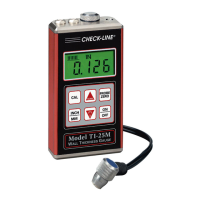– 11 –
6. The display will show a measurement value of 0.250 inches
(or 6.35 mm) if the gauge is calibrated for common steel factory
(default setting) with an acoustic velocity of 0.233 in/µs (5920m/sec).
If the gauge is calibrated for any material other than common steel then
the measured value of the Test Plate will be higher or lower than
described above. Refer to the “Equivalent Value Of Test Plate” column
of the Acoustic Velocity Table in section 6.1.
4.4 Changing Units — inches to mm
To change the measuring units from inch (factory setting) to mm, press the
key. Each time the key is pressed, the units will change.
4.5 Checking Calibration With The Probe ZeroPlate
The built-in Probe Zero Plate can also be used whenever desired to confirm
that the gauge is working properly. The steel Test Plate will measure 0.250"
(6.35) if the TI-25M is calibrated for steel (factory default) or some other
value higher or lower depending upon the material type that the gauge is
calibrated for. Refer to the “Equivalent Value Of Test Plate” column of the
Acoustic Velocity Table in section 6.1.
4.6 Preparation Of The Surface
The TI-25M can be used to measure thickness over existing paint or
coatings as long as the coating is in good condition, is well adhered to the
surface and does not exceed 0.020" (20 mils or 500 microns) in thickness.
Please note that the paint or coating thickness will be included in the over-
all wall thickness measurement.
The surface to be measured should be relatively clean and smooth, free of
any small particulate, rust or scale. The presence of any of these conditions
will prevent stable and reliable readings. Often, a wire brush, sandpaper or
scraper will be helpful in cleaning the measurement surface. In situations
where the surface is heavily corroded or pitted, a rotary sander, or grinding
wheel will be necessary to properly prepare the surface for measurement. If
the surface is still “rough” after preparation, using a more viscous couplant
fluid similar to petroleum jelly or K-Y jelly will help obtain a stable, reli-
able measurement. This type of “thick” coupling fluid is a good choice
when measuring on vertical surfaces or on the underside as it will help
adhere the probe to the measurement surface while also acting as the
coupling agent.

